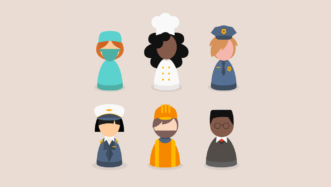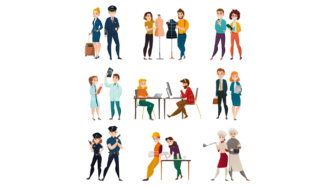LESSON OVERVIEW
The main objectives of this lesson are to:
- practise filler words and backchanneling;
- role-play workplace conversations;
- watch two short videos of small talk at work.
With this lesson, students share what they chat about with their colleagues and watch two videos of casual workplace conversation. They also explore filler words that make conversations sound more natural (e.g. I mean…, like…, so…) and backchanneling to show interest (e.g. Really?, Wow!). Finally, they role-play dialogues.
WARM-UP AND VIDEOS
This lesson begins with a warm-up. Students complete a sentence with their own ideas about what they talk about with colleagues when not working. They also give some details. Then, students watch a video where coworkers chat at the water cooler and tick what they talk about. After that, they practise filler words. Students watch part of the video again and choose the words they hear (e.g. so, cool, like, etc.) to complete dialogues. Then, they role-play the dialogues. Next, students discuss questions about small talk topics at work. Following that, they watch a second video of colleagues talking and choose the best summary of what the speakers think. Afterwards, students complete gaps with expressions (e.g. so, you know, uh, etc.). They then watch part of the video again and check their answers.
DISCUSSION
At this point in the lesson, students receive a list of questions. They ask their partner the questions and they answer using filler words. Then, students swap roles. After that, they read small talk statements (e.g. It’s so hard to focus on work on Fridays.; I hate it when it’s raining.; etc.) and choose the best reaction to each of them (e.g. I know.; Yeah.; Wow. I didn’t know that.; etc.). Finally, in pairs, students imagine they are colleagues. They choose a comment from a list (e.g. I’m really glad it’s Friday!; I love the weather today.; This coffee is delicious.; etc.) and read it to their partner. Following that, students practise filler words and have a conversation using them. The conversation should be as long as possible. If they don’t know what to say, students choose another comment on the list and continue.
HOMEWORK/REVISION
This lesson plan also includes an additional task that you can use as homework or revision. In the task, students make conversations more natural by adding filler words to them. Then, they write two sentences to finish the dialogues. The task is available in the teacher’s version of the worksheet. You can print it and hand it out to your students. It’s also included in the e-lesson plan.
WORKSHEETS
Subscribe to unlock these and many other Standalone lesson lesson plans with the Unlimited plan
Subscribe













It’s awesome!! Thank you!!
You’re very welcome. I’m glad you like the lesson 🙂
These are so cool. Thanks.
Great, thanks for the comment 🙂
That one dose not soit to most of the students who do not live in the USA . Generally , the lesson dose not give any usefull vocabulary
Hi! The purpose of the lesson is to help students have simple conversations in English. Students learn to use fillers like ‘I mean…’ and ‘You know…’. Fillers allow the speaker to take a second to think about what they want to say next. Students also learn backchanneling (words like: ‘Really?’ and ‘Wow!’) to be able to show that they are interested in what the other person is saying. Fillers and backchanneling are not regional (American or Australian) but used by all English speakers and will surely make your students more confident when having a conversation in English.